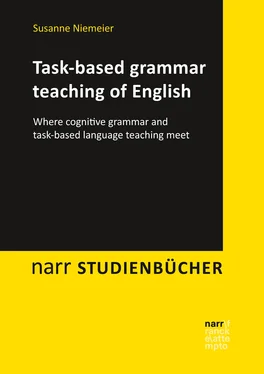1 ...6 7 8 10 11 12 ...23 KUMARAVADIVELU (2007: 20) even claims that “the biggest methodological challenge facing the classroom teacher is to cope with the unpredictable nature of task performance”. This means that teachers need to be prepared for alternative task results than those they originally had in mind and they need to be able to reorganise their lessons to a certain extent if the task takes longer than planned or, vice versa, if the learners work faster than expected. For example, it is of utmost importance never to leave out the report phase, even if time is running out, as the learners definitely need feedback and evaluation. Therefore, in some cases, the remainder of the lesson needs to be restructured so that, for instance, parts of the task can be left out in order to have enough time for the reports and the teacher’s ensuing feedback.
Language learning is no linear process and therefore there is no ideal way of learning for just about everybody. All learners bring with them individual, cognitive and motivational differences, which can only be catered for if the teacher sets meaningful tasks and promotes motivating activities in which the foreign language is used. Every learner may gain slightly different outcomes and advancements of their respective interlanguage from such tasks and there will never be completely unified results.
When planning a task-based lesson, the easiest way is to rely on an established framework. Various methodological designs exist, which all have in common that they consist of three main phases (pre-task, during-task, post-task). The best-known three-phase model comes from WILLIS (1996), who has developed a generalizable framework for task-based language teaching which has been widely accepted and which will also be followed by this book, although it will be modified at some points. The framework allows for creativity and variety in all of its phases. WILLIS uses the term “task cycle” for the middle part (which includes the actual task, the planning of the learners’ reports and the reports themselves), but many other researchers (such as, for example, NUNAN 2015) use the term “task cycle” for the complete framework, which – as has already been indicated – consists of three main stages, the middle stage being divided into three further sub-stages. This book follows NUNAN’s way of using “task cycle” for the complete model.
Usually, a task cycle takes up one lesson. It is, however, possible that a lesson may consist of several task cycles (what NUNAN calls “several linked tasks or task chains”, 2015: 12) or else, that a task cycle can span over several lessons. With one exception (the case study on verb complementation), the examples provided in the second part of this book all take up one lesson each.
The task cycle begins with the pre-task phase, which is normally the shortest of the three stages. It has several important functions: on the one hand, it is meant to reactivate useful vocabulary or turns of phrases and to allow as many learners as possible to already say something in the foreign language, and on the other hand, it introduces the learners to the communicative topic of the lesson, which should motivate them1 and in an ideal case should be drawing on their background knowledge. If, for example, the topic relates to healthy nourishment, the teacher can start the lesson by telling the learners that s/he does not feel well because the night before s/he ate too many unhealthy products for dinner and can continue by asking the learners for alternative food suggestions, drawing on their world knowledge and at the same time on their knowledge of food vocabulary. The learners’ suggestions, presumably words for fruits and vegetables, can be collected on the board or on flashcards and can later on be consulted by the learners during the task phase.
Concerning grammar, the topic ‘healthy food’ is well-suited for introducing the plural – s , as fruits or vegetables can either be mentioned in the singular or in the plural. If the learners did not yet have any conscious contact with pluralization and answer the teacher’s question “What should I have eaten instead?” with “an apple” or “a banana”, the teacher can comment “This is true, apples/bananas are much healthier”. Thus, during the pre-task phase, the teacher should already use the grammatical structure that is to be acquired but should not expect the learners to already use it as well.
A final important function of the pre-task phase is to provide the learners with the task instructions, i.e., to introduce and explain the upcoming task and to make sure that all learners know exactly what they have to do and how much time they have to do it. Especially for lower grades, it has proven helpful to not only explain the task verbally, but to also show a slide with a step-by-step procedure and let it remain visible throughout the task, so that the learners can refer to it if necessary. Should worksheets be distributed, the step-by-step procedure can alternatively be printed on the worksheet. Also R. ELLIS (2003: 222) recommends not to rely on oral information alone: “With regard to input medium, information that is presented in written or pictorial form, which can be decoded in the learner’s own time, is likely to be easier to process than information that is provided orally, which requires online decoding”.
The task phase consists of three steps, namely the task itself, the planning of the learners’ reports on the task outcome1 and finally the reports themselves. A task is normally done in learner-learner interaction, either as pair work or in small groups. On the one hand, this increases the quantity of learner speech, as in teacher-class interaction only one learner can speak at a time, but in pair or group work many more learners can speak at the same time. This effect is even more pronounced in pair work, as everybody needs to be active and cannot try to hide behind others who may dominate the discussion floor in a group. On the other hand, pair or group work is important for authentic communication to arise as the learners have enough time to communicate outside of the teacher’s control.
Also R. ELLIS (2003: 178) stresses the importance of learner collaboration, arguing that “tasks (…) can be seen as tools for constructing collaborative acts” and, later on in his book, he speaks about “cooperative learning through collaborative dialogue” (2003: 269), i.e., the learners’ social skills are trained as well. Furthermore, learners who are anxious or nervous when they have to speak in front of the whole class may feel less nervous in pair or group work. It is usually best if the groups or pairs are formed under the teacher’s guidance, as this is a lot quicker than letting the learners find their own groups. Still, in order not to force the learners into predetermined groups, the teacher may, for example, let them draw numbers (i.e., if five groups have to be formed, the numbers on little pieces of paper go from 1 to 5 and everybody who has a ‘1’ is in ‘group one’ etc.) or colours (i.e., bits of paper which are coloured on the inside and everybody who has a yellow piece of paper, is part of ‘group yellow’ etc.). In this way, the learners cannot blame the teacher for having put them in a group they do not appreciate but they are themselves responsible for having drawn their groups.
While working on the task, the learners are expected to already use the new grammatical structure during their interaction and especially when formulating their reports, which can be facilitated by giving them clearly structured tasks. Example sentences on a worksheet are helpful as well. To pick up the ‘healthy food’ topic once more, the learners could be given a worksheet with a shopping list and can be told in the instructions on the worksheet that they are invited to a birthday party and have been asked to bring a fruit salad. The next item that appears on the worksheet would then be a list with the heading ‘shopping list – fruit salad’ and then several dotted lines, the first two or three of them could already be filled in with ‘1 melon’, ‘5 pears’, ‘3 bananas’ or similar.
Читать дальше












